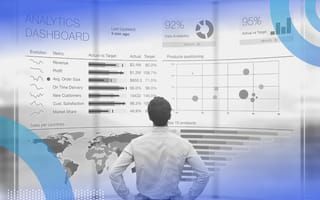Business intelligence (BI) is a specialist function that uses technology, data tools and services to provide insights that guide business decisions and business monitoring. These insights often take the form of metrics and visualized data to give an overview of the organization’s current state.
Business intelligence was developed as a specialist area of expertise to take advantage of the growing volumes of data and information stored by corporations. The business intelligence function is a specialist area that helps businesses create value from these data stores.
How the Business Intelligence Process Works
The business intelligence function is generally responsible for three stages of work in delivering information to the organization.
The Business Intelligence Process
- Data collation from various sources
- Data transformation and storage
- Business reporting
The BI function’s first major area is collaborating with various teams to source and collate the data needed to address a particular knowledge gap. Collation of data can involve various work streams such as setting up data logging within a product or sourcing data from various databases.
The second important step within the BI function is to transform, quality check and store data. Business intelligence maintains this information on an ongoing basis, most often in databases.
The third area of work is to report the insights and information to the organization via dashboards, reports and other channels. This may include a mix of supported business dashboards, self-serve tools and ad-hoc outputs.
Business Intelligence Tools
Business intelligence functions use a variety of tools in order to collate, transform and store data, as well as deliver business reporting. Some of the tools BI professionals use include:
Pipelines, ETL Tooling and Database Platforms
BI teams use data tools to source data at scale, quality check information, prepare data for various use cases and store data.
Data Mining Tools
Business intelligence teams may spend a good deal of time mining data by way of manual queries or reporting tools that query predefined databases in order to present business insights.
Data Visualization Tools and Software
Business intelligence teams make use of data visualization tools to present data and trends in an accessible format. Data visualization is often used by BI teams to provide the business with self-service information.
Spreadsheets
Spreadsheets continue to be a key component of BI work. They’re flexible tools with a wide variety of features that BI teams can use in a sophisticated way. Spreadsheets are a valuable tool because they don’t require in-depth specialist training, which means they’re accessible to many functions within a corporation.
Reporting Software
BI teams and functions are often responsible for corporate and regulatory reporting. Business intelligence teams will often use software or formalized reporting tools to provide these outputs.
Types of Business Intelligence
Broadly speaking, there are three categories of business intelligence work:
- Ongoing Business Intelligence: Business Intelligence functions often maintain a variety of reports, dashboards and self-service tools used by various teams throughout an organization to operate the business.
- Formalized Reporting: Business intelligence functions may be tasked with formalized reporting such as regulatory, financial, investor or other corporate reporting.
- Exploratory Business Intelligence: Business intelligence may also engage in exploratory intelligence gathering and reporting to uncover other data stores or sources that may help organizational leaders.
Benefits of Business Intelligence
There are many benefits to investing in a business intelligence function.
Business intelligence functions often provide a single source of truth for critical business metrics, ensuring there is a clear view on particular bits of information across the organization. They achieve this by being the specialist center, quality checking data and validating metrics to ensure they are accurate.
Business intelligence functions surface critical business metrics to support decision making across the organization. They work to ensure information is disseminated widely in various formats such as self-serve dashboards and reporting.
There appear to be few disadvantages as a result of improved business information. Some forms of self-service BI can lead to confusion if stakeholders misunderstand or misinterpret dashboards or visualizations.
That said, well-resourced BI functions may include training and extensive documentation alongside sharing self-service tools in order to limit misinterpretation.
Business Intelligence Use Cases
Business intelligence functions support a wide variety of business areas such as finance, marketing, product and human resources with critical business insights.
Here are a few sample applications:
Finance
Within finance, a business intelligence function may develop and own the lifetime value (LTV) work stream. This involves sourcing data inputs to construct the LTV data tables, building the LTV dashboards and distributing reports around LTV updates such as changes to LTV in specific countries. Business intelligence may also take on a regulatory reporting role, setting up the systems to produce company reports and financial statements.
Marketing
Supporting marketing, a BI function may build and maintain ongoing reports on total addressable market (TAM) by customer segment. Knowing TAM involves sourcing data on customer numbers, competitive customer numbers, industry specific data to know total possible customers (such as web users for internet-based products). After data sourcing, BI teams deliver insights to marketing teams on a regular basis to develop a data-driven marketing strategy.
Product
In the product space, a business intelligence function may own a number of projects, one of which may be maintaining accurate customer numbers by product feature. This would include basic customer segmentation, such as noting volumes of customers (based on whether they are daily, weekly or monthly users) or whether the numbers represent repeat or net new customers. This kind of data collection involves sourcing and quality checking data on customer numbers and visualizing the information for business leaders.
Human Resources
In the human resources space, a BI function may take on the role of regular reporting to senior leadership on critical staffing metrics such as turnover, hiring trends and overall company size and growth. There may also be a regulatory component to business intelligence work in the human resources space where the function needs to produce consistent reports on salaries by demographic.





